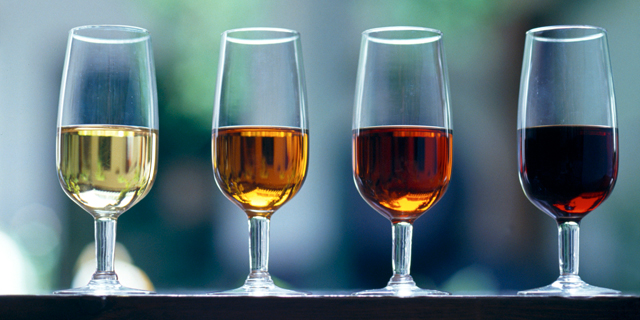Sherry wine is, along with Portugal’s Port and Madeira, one of the three classic fortified wines of the world and the most famous of Spanish fortified wines. Since 1996, its name has been legally recognized as belonging exclusively to a demarcated area west of Spain’s Andalucia region. And though sherry has suffered a decline in popularity over recent years, it has revived itself slightly in Spain, the US, and elsewhere. Here, everything you need to know about Sherry, including how to pair it.
The Sherry Dictionary
There are at least eight distinct styles of Sherry, each with its own flavor. Here’s the breakdown.
Fino
Along with Manzanilla, this is the lightest and finest of sherries. Dry, pale, delicate but pungent. Should be drunk cool and fresh. Deteriorates rapidly once opened. Tip: Always refrigerate and use half bottles, if possible.
Try: Domecq La Ina, Lustau Puerto Fino, Osborne Fino Quinta.
Manzanilla
A pale, dry sherry with characteristics unique enough for its own Denomination of Origin; often more delicate than a Fino and strictly matured in more maritime conditions of Sanlúcar de Barrameda (as opposed to the other, more inland sherry towns of El Puerto de Santa Maria or Jerez).
Try: Hidalgo-La Gitana La Gitana.
Amontillado
A Fino in which the layer of protective yeast, “flor”, which rests atop the wine in barrel has died, allowing the wine to come in direct contact with air and creating darker and more powerful characteristics. Naturally dry.
Try: Herederos de Argüeso Viejo, Valdespino Tio Diego.
Oloroso
Heavier, less brilliant than Fino when young, but matures to richness and pungency due to its aging in barrel with total oxygen exposure. Naturally dry, often sweetened with Pedro Ximenez for sale as oloroso dulce.
Try: Tradición, Williams & Humbert 15 year Sweet
Next, more delicious Sherries…
[pagebreak]
Palo Cortado
A rare style falling somewhere between amontillado and oloroso in character. Dry, rich and typically complex– worth looking for.
Try: Barbadillo Obispo Garcon, Emilio Hildago Privilegio 1860, Gutiérrez Colosía Viejissimo, Harvey’s.
Cream Sherry
A blend of varying amounts of any sherrys, sweetened with grape must, PX, and/or Moscatel for a consistent, inexpensive, medium sweet style.
Pedro Ximenez/PX
Both a grape variety and a style. From partly sun-dried (soleo) grapes which, like port, has its fermentation arrested by the addition of grape spirit and so retains its natural sweetness along with a slightly elevated alcohol level. Concentrated, unctuous, decadent and relatively inexpensive. Overall, the world’s sweetest wines.
Try: González-Byass Noe, Rey Fernando de Castilla Antique, Tradición.
Moscatel
Similar to Pedro Ximenez, though it rarely reaches PX’s level of concentration or richness.
How to Pair Sherry
Through its association with tapas, Sherry has, once again, become a respected and trendy drink, moving away from the reputation it suffered in the 1980s as the old, dusty bottle of liquor that got dragged out of the cubbard for the winter holidays. Past tapas, it remains customary to enjoy a chilled glass of Sherry with the opening bowl of olives and/or finish with a cool or room temperature glass of PX or Moscatel with the flan or helado.
Only the foolish would argue against the affinity of Sherry with most Spanish cuisine. But, how about Sherry with other foods? Here are the best ways to pair them.
Manzanilla
Pair with raw fish dishes, briny raw oysters.
Fino
Pair with grilled and fried versions of fish.
Olorosos
A cream or young sweet Oloroso can be a delicious companion to the sweeter barbecue sauces used on grilled meats, while dry and pungent Olorosos are great alternatives to hearty reds for use with wild mushrooms, dry aged cheeses, lamb, hare, and venison. Lamb accented heavily with oregano and garlic in the Greek style or with the addition of olives à la Provençal, is great with a younger Oloroso. Stilton cheese, traditional goat and sheep’s milk cheeses of Spain, or the classic French Roquefort can pair well with an old and/or sweet Oloroso.


![Making Mealtime Matter with La Familia: Easy Sofrito [Video]](https://thelatinkitchen.com/wp-content/uploads/2015/10/sofrito-shutterstock__0-500x383.jpg)
![Easy Latin Smoothies: Goji Berry Smoothie [Video]](https://thelatinkitchen.com/wp-content/uploads/2015/12/goji_berry-shutterstock_-500x383.jpg)
















![Fun and Fast Recipes: Fiesta Cabbage Salad [Video]](https://thelatinkitchen.com/wp-content/uploads/2015/11/fiesta_cabbage_slaw-shutterstock_-500x383.jpg)









